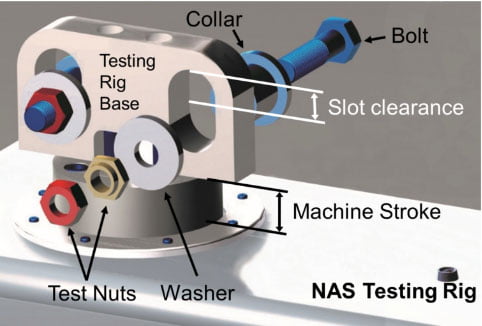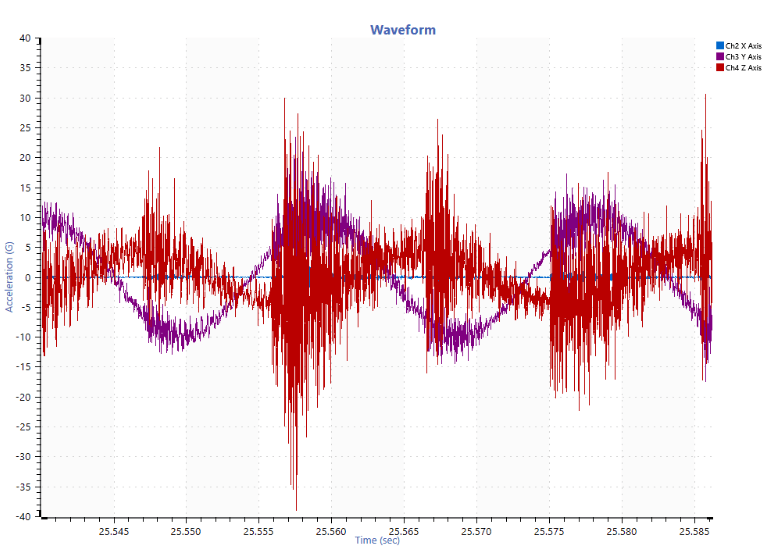Small components can cause the most serious failures, so the potential risks of any component should not be overlooked during product development.
Taking fasteners as an example, when ready-made fasteners are used under dynamic load conditions, unexpected problems may occur. Vibration under working conditions, especially under extreme excitation, can cause fasteners to loosen.
The loosening of fasteners is a gradual process. While engineers who perform regular machine maintenance may find problems before they occur, products received by customers are typically not subject to such frequent inspections. This loosening problem can be ignored and can eventually lead to failure, sometimes with serious consequences. Therefore, It is very necessary to perform fastener vibration testing.

The NAS vibration test is a mechanical test used to verify that a bolt will loosen when subjected to a lateral impact load. The test method shall comply with the metric specification NA0009 and the uniform fastener specification NAM1312-107. The test stand shall be designed and operated in accordance with NAS3350 standards.
The fastening test device consists of a body provided with an oval slot or hole for mounting the collar. The sleeve ring is combined with the washer to form a bolted assembly. These washers and bushings are placed in the grooves of the body for fixing by test bolts and nuts. The ring can move vertically and freely within the ring of the main body. Finally, the fastening test device is installed on the vibration plate of the electrodynamic vibration test system.
After the test begins, the tester lifts the test bench up and down so that the sleeve ring of the bolt component moves freely within the limit of the test bench slot and repeatedly contacts the top and bottom of the slot wall when colliding. Each time the collar collides, the washer continues to carry forward momentum, causing it to slide at the gasket-collar interface, exerting a bending force on the bolt. The duration of the vibration is short, but the amplitude is large. This impact easily overcomes the friction on bolted surfaces such as bearing surfaces and threads.
Unlike the Junker test, the loosening criterion does not consider the loss of the joint preload. After approximately 30,000 cycles (about 17 minutes) of vibration with a frequency of 1780 to 1800 cpm, the relative rotation of the bolt is checked. If the relative rotation is less than 1 full turn (360 degrees), the nut is considered to pass the test; Otherwise, it is considered a failure. In order to evaluate the fasteners more fully, the time elapsed before failure and the number of cycles can also be considered.
NAS vibration test is suitable for comparing the anti-vibration effect of fasteners. However, this test method is not suitable for detailed analysis of fasteners, because it is difficult to record the change in the preload over time, and it is difficult to identify the change in the preload.

Resonance is one of several vibration phenomena that cause fasteners to loosen. To this end, we conducted a fastener vibration test, similar to a proof-of-concept phase, to monitor the effect of resonance frequencies on nut and bolt fastening.
The resonance frequency of the stent was determined by sinusoidal scanning, and the result showed obvious resonance phenomenon in the range of 51 to 54 Hz.
Nuts and bolts of different sizes are loosely fastened to the car winch bracket without the use of locking nuts or thread locks. A vibration test was performed on the bracket with fasteners in the range of 51 to 54 Hz.
Vibration on the x, y and z axes was measured by a three-axis accelerometer. The vibration direction is perpendicular to the bolt, but the excitation signal is mainly recorded on the y and z axes. The resonance may introduce vibrations in the horizontal axis that are large enough to cause the nut to loosen or reverse.

The loosening of the firmware underscores the importance in replicating the actual operating conditions of the product. Engineers need to understand how the product will perform in the end-use environment at an early stage of product development, such as in-depth knowledge about fastener vibration testing such as: For information on “Junker Test – Transverse Loading”, “Torsional or Angular vibrations”, etc., please feel free to contact our engineering team. We are always here to provide you with answers and support.